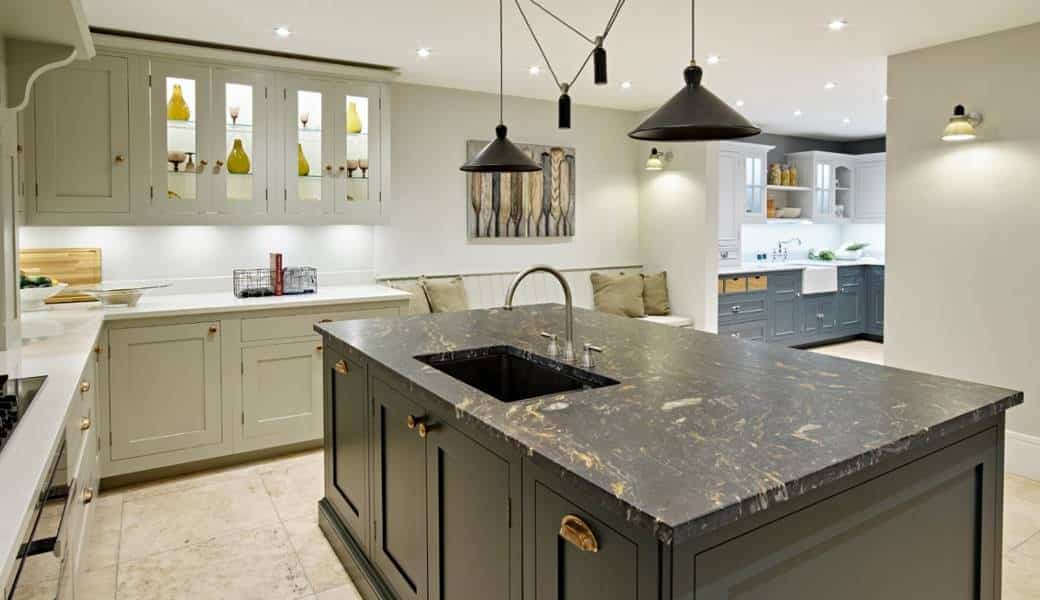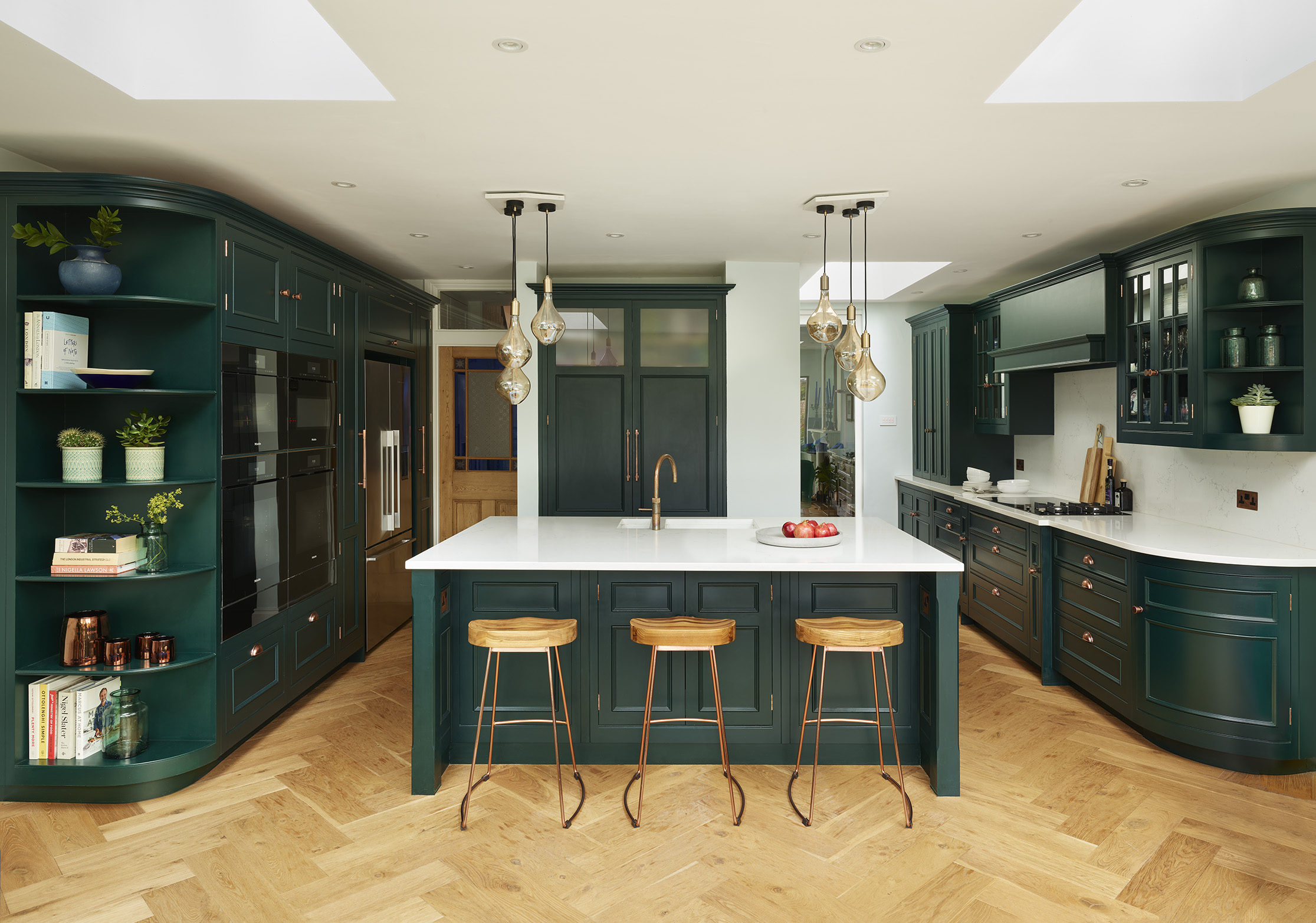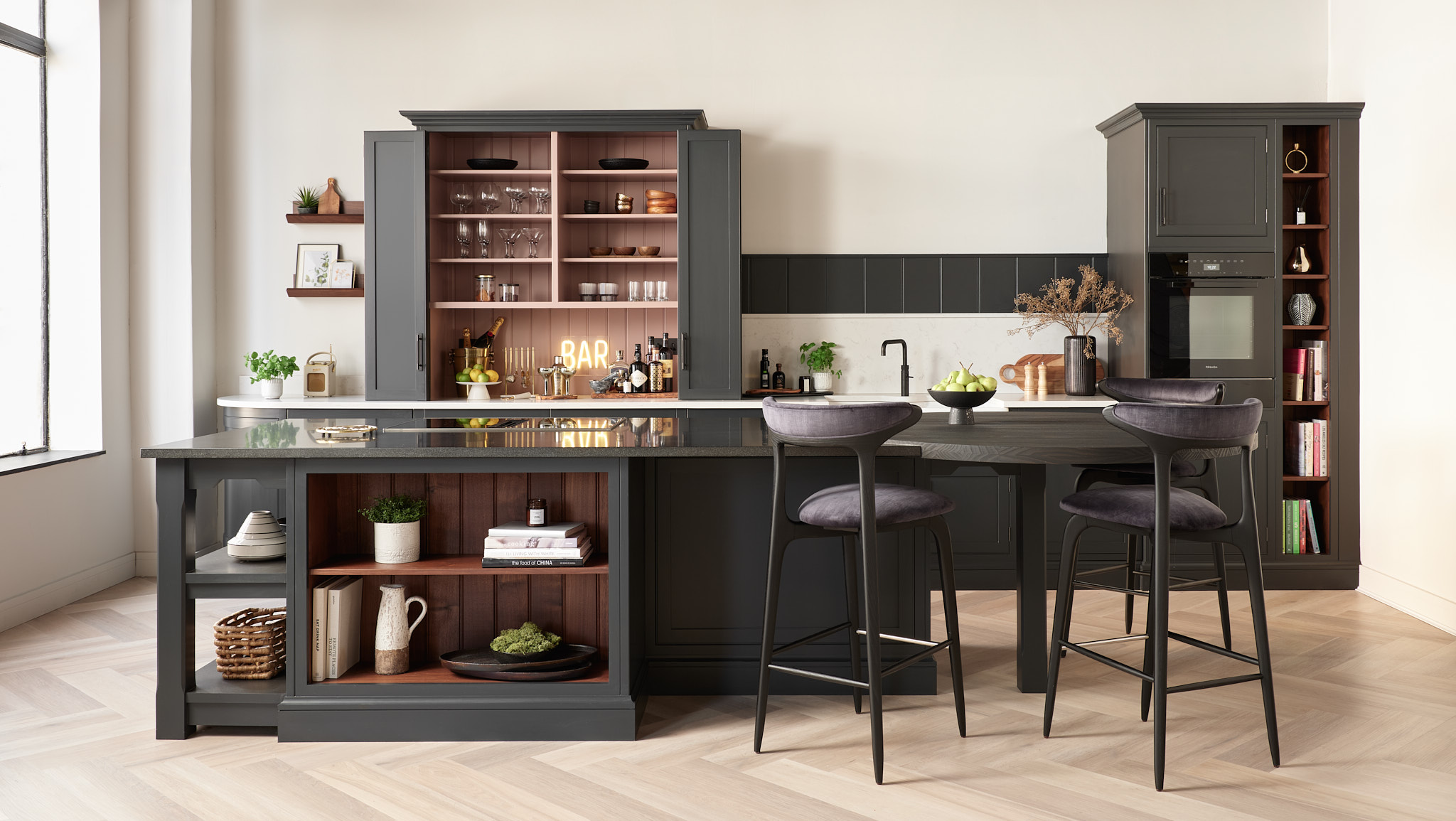
Essential and hardworking, sinks are often the forgotten stars of the kitchen, but it is important to give them plenty of thought before you choose one. This is a key piece of kit — after all, even with a dishwasher, you’d never manage without a sink — and the latest design improvements mean you want one that performs efficiently and looks great. The size and style of your kitchen design will probably have a major influence on your choices, but whether you have a bijou city space or a big open-plan farmhouse kitchen, this guide will help you pick the perfect sink.
TYPES OF SINKS
TOP-MOUNT SINKS
Also known as a drop-in or inset sink, this is the most common type of kitchen sink. It’s inserted into a hole cut directly into your countertop, with the edge creating a rim which supports the sink’s weight. This is the most affordable option, though not everyone likes the look of the rim.
UNDERMOUNT SINKS
This is the opposite of a top-mount sink as it is installed underneath your worktop instead. This creates a sleek, streamlined finish that perfectly complements a minimalist kitchen, and without a rim, you can easily sweep water and debris directly into the sink. However, sizes may be limited with this design.
FARMHOUSE SINKS
Farmhouse sinks have large basins and a front wall which also forms part of the counter, allowing you to get closer. The generous size is ideal for washing bigger pans, though water may drip down the front of the sink and onto the floor.
DRAINBOARD SINKS
This combines a sink with a drainboard that catches water while items are drying and drains it back into the sink. However, if you have a large family or like entertaining guests regularly, you may find that the basin will probably be too small.
INTEGRATED SINKS
An integrated sink is fused with your worktop and made from the same material. These sinks are becoming a more popular choice due to the bespoke nature and attractive design; however, these sinks can be expensive due to the fact they are custom-made. It’s also worth noting that if the sink breaks, it can’t simply be removed and replaced.
CORNER SINKS
You can have two basins installed at a corner of your countertop — one on each side of the right angle. This is a great way to make use of corner space that often goes unused, and you could even have a drying area between the basins if there’s room. However, these can be expensive, hard to find, and may weaken this part of the countertop.
ISLAND SINKS
If you’re considering an island in your kitchen design, you could incorporate a sink. This addition makes it easier for multiple people to prepare food simultaneously. However, you will need to consider water supply and drainage as this may not be possible in all kitchens.
KITCHEN SINK CONFIGURATIONS
SINGLE BOWL SINKS
These have one basin and offer plenty of space for washing big pots, pans and dishes. And if you choose a drainboard single bowl, you have a drying area too.
1.5 BOWL SINKS
In addition to the main basin, there is also a small bowl offering more space for extra washing or draining.
DOUBLE BOWL SINKS
Double bowl sinks have two basins, letting you allocate different activities to each side, like washing in one and draining in the other. There is also a low divider option which offers even more flexibility. Though this is technically a double bowl sink, the divider stops part way up, so you can allow water to flow over the top and effectively make it a single basin. However, a double bowl sink leaves less room for large items than a single one.
KITCHEN SINK SIZES
Your kitchen sink could be anything from 9” to 40” long, depending on its main purpose and the space you have. Single bowl sinks are typically between 24” and 30” in length, while double bowls will be bigger and food prep sinks will be smaller. It’s also important to consider the width and depth of the basin. Wider, deeper sinks will be needed if you plan to handwash your dishes, for example.
Measure your current sink, and either stick with the same size, or work out what alterations would need to be made if you’re upgrading. For example, some in-wall plumbing modifications may be required to accommodate a deeper sink. Your kitchen designer will advise you on this and help you pick the right size in terms of your space and budget.
KITCHEN SINK MATERIALS
Stainless steel
Stainless steel is the most popular material, renowned for its hygienic properties, durability, affordability, and ever-increasing choice of designs. It’s also very easy to clean, though fine scratches will develop over time. Invest in a stainless steel sink that’s 18% chromium and 10% nickel to ensure it stays tough and rust-proof.
Ceramic
White ceramic styles such as Belfast or Butler sinks are perfect for classic or country-style kitchens, and have a porcelain-coated fireclay finish, making them stain and heat resistant.
Composite
Composite sinks are more expensive than stainless steel and ceramic ones, but great at withstanding high temperatures, scratches, chips and cracks. Lots of different stones are used in their composition such as quartz and granite, offering plenty of choice when it comes to colour and texture.
Corian
Corian is a relatively new alternative but is growing in popularity. Another highly durable, stain resistant material, it’s also the one to go for if you want your sink to be a seamless continuation of your work surface.
Glass
Glass sinks are an eye-catching, contemporary choice. These are strong and don’t stain or scratch, and while they can cope with general wear and tear, sudden temperature changes could cause cracks.
Wood
If you’re after a real wow factor, wooden sinks are an interesting pick, especially teak which has great antibacterial properties. However, opting for timber around wet areas is high maintenance, and you’ll have to properly care for it to prevent mould from developing.
WHICH KITCHEN SINK IS BEST FOR YOU?
If you have a big family or entertain on a regular basis, then a deep rectangular sink big enough to hold roasting pans and casserole dishes is a must-have. Double bowl sinks are ideal if you have the space for them, as you can allocate different activities to each, while if you only need a smaller second bowl for hand washing or veg prep, a 1.5 bowl sink is a great alternative.
The material you choose mostly depends on the look of your kitchen. For example, stainless steel is more contemporary whereas ceramic is perfect for a traditional home. However, you also have to consider how much time you want to spend cleaning and caring for your sink, and make sure it complements the worktops and taps you choose.
There are also additional features you could incorporate into your sink, such as a waste disposal unit to get rid of food waste, or if you have a small kitchen, choose one with accessories like a wooden chopping board or sliding glass cover. When fitted over the bowl, these can double up as an extra work surface or prep area, making the sink much more versatile.
If you need some help choosing a kitchen sink or have any other aspects of kitchen design you want to discuss, call 0800 389 6938 to speak to a Harvey Jones designer in your local showroom, or click here to request a complimentary design consultation.






